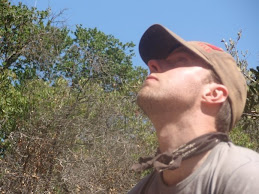I'm always interested when I come across - by reading, usually - folks developing "new forms of life", a topic that, without fail, sparks the imagination; for me, it has always been this way (as an incorrigible daydreamer). While I'd like to think that, over the years, my education and experience would allow me to cast more subtle molds around the subject.. I must admit that crazy animal hybrids are still the first things that come to mind when I hear the phrase "new forms of life". Liger, anyone? haha.
But then my (ahem) deeper intellect takes hold, and I think of the possibilities for maybe some less-extravagant flora and fauna; more specifically, my attention turns to transgenic organisms, in all their controversial, and financially-lucrative glory. In fact, Christmas is almost here and I've always wanted a GloFish®, or a bunch of cancer fighting tomatoes. Both would be great in a salad, I bet. But I digress..
It's rare when I'm blown away by something - especially something I read/see on the Internet, ha! - but I came across the work of Theo Jansen today, a man at the crossroads of art, engineering, and insanity (in a good way!). His creations, well, at first, shocked me, and then, they made me a little uncomfortable; finally, I settled into amazement. Mr. Jansen is best known as a kinetic sculptor, but that title doesn't do him justice; simple mobiles these are not.
From his website (transcribed sans typos):
"Since about ten years Theo Jansen is occupied with the making of a new nature. Not pollen or seeds but plastic yellow tubes are used as the basic material of this new nature. He makes skeletons which are able to walk on the wind. Eventually he wants to put these animals out in herds on the beaches, so they will live their own lives."
Behold his Strandbeests!
While nice as a teaser, a still photo of these massive, protoanimal devices should only be used to whet your appetite for watching videos of their incredible locomotion.. once they get going, that is. You see, the metabolism (I use the term loosely, in the spirit of the project) of most of the creatures is based on the wind; early ones used this energy source directly, turning beautiful sails or propellers that would then actuate their manifold legs, while later generations - who said evolution is dead? - have additional facilities to store this sort of energy for later use. Lemonade bottles never had such a glorious existence.
So, without further ado, check these videos (and if you're thinking about eating a brownie beforehand, then I would say to eat the brownie):
1. First, indulge in discovery. VIDEO #1!
2. Now, listen to Theo Jansen present several of his designs to an audience at a TED conference earlier this year; he talked about "The art of creating creatures". I will admit that occasionally he sounds like a madman, but his commitment to his ideas - and the ideas themselves - is/are fascinating. VIDEO #2!
3. Finally, watch more action of a Strandbeest on the beach - its natural habitat, of course - as it detects if/when it arrives at water's edge and reverses its direction, surely avoiding a dramatic and oceanic death. As you can imagine (or, as you heard, if you watched VIDEO #2 above), these lifeforms are very susceptible to drowning. VIDEO #3!
To see the Strandbeests in real life, get thyself to the Netherlands! Hmm.. it is tempting; you never know how one's travel plans with shake out. ;)
In any case, beyond the visceral amazement, knowing about this project - especially after hearing Mr. Jansen explain his (physical and philosophical) mechanisms - gets you thinking about what characterizes "life" itself. As I've alluded to, or, I guess, have said outright, hearing the artist say that he is developing "new forms of life" from plastic rods and lemonade bottles sounds fantastical at best, and (pleasantly) insane at worst. Still, let's keep in mind that definitions change all the time, as new information comes to light, or new ways of interpreting data are developed. Think about such debates surrounding viruses, prions, and other biological phenomena that straddle the boundaries of what it means to be alive. Pushing those boundaries further, Stephen Hawking once posited that "computer viruses should count as life"; needless to say, that comment caused quite a stir in the academic community.
But regardless of how you choose to define existence, what is *not* in question is the genius of the artist, the engineer, the man, Theo Jansen. And I hope he continues to evolve his Strandbeests so that one day he can realize his dream: to behold herds of them autonomously patrolling the beaches of his native Nederland. Wild!
Wednesday, December 19, 2007
An approximation of insanity
Subscribe to:
Post Comments (Atom)

No comments:
Post a Comment